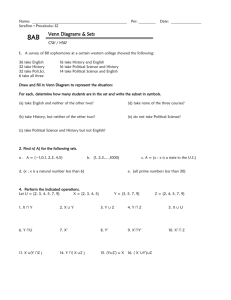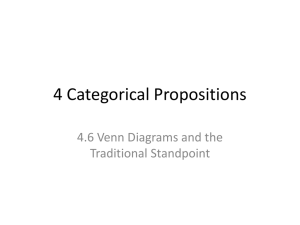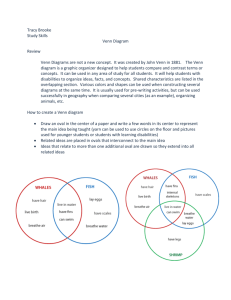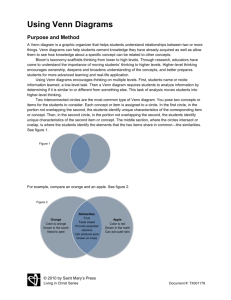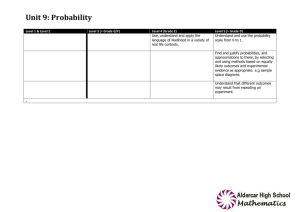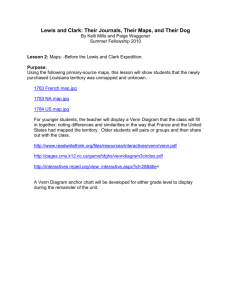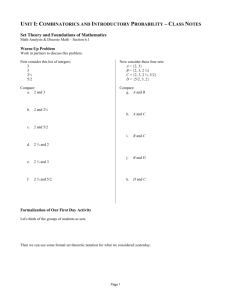Tree diagrams
advertisement
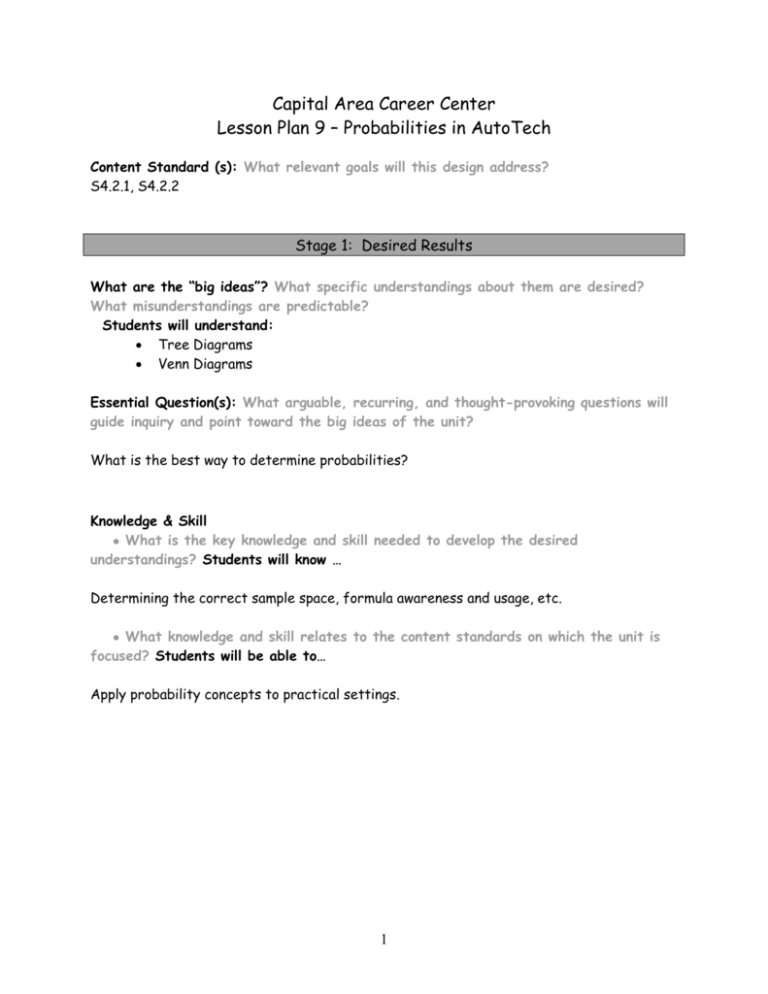
Capital Area Career Center Lesson Plan 9 – Probabilities in AutoTech Content Standard (s): What relevant goals will this design address? S4.2.1, S4.2.2 Stage 1: Desired Results What are the “big ideas”? What specific understandings about them are desired? What misunderstandings are predictable? Students will understand: Tree Diagrams Venn Diagrams Essential Question(s): What arguable, recurring, and thought-provoking questions will guide inquiry and point toward the big ideas of the unit? What is the best way to determine probabilities? Knowledge & Skill What is the key knowledge and skill needed to develop the desired understandings? Students will know … Determining the correct sample space, formula awareness and usage, etc. What knowledge and skill relates to the content standards on which the unit is focused? Students will be able to… Apply probability concepts to practical settings. 1 Stage 2: Assessment Evidence What evidence will be collected to determine whether or not the understandings have been developed, the knowledge and skill attained, and the state standards met? [Anchor the work in performance tasks that involve application, supplemented as needed by prompted work, quizzes, observations, etc.] Performance Task Summary: Summary in G.R.A.S.P.S. form Rubric Titles (Key Criteria) Probability: Type Students will collect data related to a realworld situation, calculate probabilities for multi-event situations, and prepare a report to an audience appropriate for the situation. Usage: Appropriate for the situation. Probability calculated Formative Assessment Summative Assessment Presentation, Authentic, Program Contextual End of Unit/Course, Standardized, CACCwide 2 Stage 3: Learning Activities What sequence of learning activities and teaching will enable students to perform well at the understandings in Stage 2 and thus display evidence of the desired results in stage one? Learning Activities: Consider the W.H.E.R.E.T.O elements: Tree diagrams Tree diagrams allow us to see all possible outcomes of an event and calculate their probabilities. Each branch in a tree diagram represents a possible outcome for an event. If two events are independent, then the outcome of one has no effect on the outcome of the other. For example, if we toss two coins, getting a head with the first coin will not affect the probability of getting a head with the second coin. Example 1 Three coins are tossed. What is the probability of getting: 1. three heads? 2. two heads and a tail? 3 The Answer From the tree diagram we can see that there are eight possible outcomes. To find out the probability of a particular outcome we need to look at all the available paths (set of branches) in the tree diagram. 1. Only one path has three heads, so the probability of getting three heads is: Another way to look at it is by multiplying the individual probabilities: 1 1 1 1 x x or .5 x .5 x. 5 = .125 2 2 2 8 2. Three of the outcomes show two heads and a tail, so the probability of getting 3 two heads and a tail is: or 3 x (.5 x .5 x.5) = .375 8 4 Example 2 At the Ingham County Health Department, 58% of the clients are female, 23% are low or non-English speakers, and 69% are of child-bearing age. 1. If an average of 743 clients have appointments each week at the Health Department, how many are female, low or non-English speakers of child-bearing age? 743 x .58 x .23 x .69 = 68 clients 2. Why is this important for the Ingham County Health Department to know? Venn Diagrams A Venn diagram is a drawing, in which circular areas represent groups of items sharing common properties. The drawing consists of two or more circles, each representing a specific group. This process of visualizing logical relationships was devised by John Venn (1834-1923). Each Venn diagram begins with a rectangle representing the universal set. Then each set in the problem is represented by a circle. Any values that belong to more than one set will be placed in the sections where the circles overlap. 5 The Venn diagram at the left shows two sets A and B. Values that belong to both set A and set B are located in the center region labeled A ^ B where the circles overlap. The notation A v B represents the entire region covered by both sets A and B. If we cut out sets A and B, the remaining region in U would be labeled ~(A v B). ** The most interesting features of Venn diagrams are the areas or sections where the circles overlap one another -- implying that a sharing is occurring. Example 3 During a 6 month time period in the AutoTech Program at CACC, a total of 350 cars had general service appointments. This information is shown in the Venn Diagram below: 6 Oil Changes 125 18 38 6 87 27 Tire Balance 48 Coolant Flush 1. How many vehicles were serviced for only a coolant flush and a tire balance? 2. How many vehicles were serviced for a coolant flush or a tire balance? 7 3. How many vehicles were serviced for one service only? 4. How many vehicles were serviced for all three services? 5. How many vehicles did not have any of the 3 services? 6. Why would this be important for a service center to know? GLOSSARY OF TERMS 8 G.R.A.S.P.S. form for performance task: Goal Role Audience Situation Product/Performance/Purpose Standards & Criteria for Success Consider the W.H.E.R.E.T.O. elements for structuring learning activities: Where – Help the students know where the unit is going and what is expected. Help the teacher know where the students are coming from (prior knowledge, interests). Hook – Hook all students and hold their interest. Equip – Equip students, help them experience the key ideas, and explore the issues. Provide – Provide opportunities to rethink and revise their understanding and work. Evaluate – Allow students to evaluate their work and its implications. Tailored – Tailored (personalized) to the different needs, interests, abilities of learners. Organized – Organized to maximize initial and sustained engagement as well as effective learning. 9

